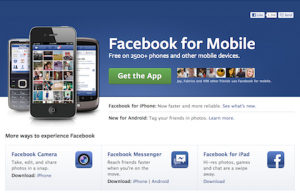
As technology advances further, products and services become more and more affordable. Cellphones have become a commodity and internet has become more available. And so will Facebook also be through its “Facebook for Every Phone.” The social network giant is developing a platform which will make the service accessible in cheaper phones at cheaper or no cost to low income portions of populations in developing countries like Brazil, India, Indonesia, Mexico, Vietnam and many more.
The mentioned developing countries are some of the fastest-growing market for the internet and social networks based on studies conducted by research firm eMarketer. Almost the entire populations of these countries are using mobile phones and the majority are in the lower bracket who use the cheap models. In the latter, the social network service will be provided by Facebook for minimal or no fee. The software is also available to
Facebook is partnering with phone manufacturers and carriers to bring their service to the poor bracket of the populations of developing countries for minimal or no fee. The biggest social network in the world has been developing the new platform for more than two years now. Even though they already have 1.1 billion users around the world, the site is viewing technology more broadly and more deeply and is reaching out to the poorer population. More so, it wants to expand its user reach by tapping into the potential of its mobile users. This group which uses cellphones to access the social network take up one eighth of the total Facebook population and amount to 100 million users.
The cheap phones which are also known as “feature phones” can be bought for as low as $20. With the phones, users will be able to view and download their Facebook news feeds and photos for prices which are very low or, better, non-existent. The phone maker partners of the social network will be the ones who will absorb all or part of the cost through subsidy. The move of the social network behemoth to tap into its mobile users market and the poorest section of the population is a good response to the migration of many technology and cyber users from computers to mobile gadgets. It will enable Facebook to cushion the impact of the user bahaviour change especially on its profit.
Through the cheap phones and very low browsing charge, Facebook is in a very powerful position where it can introduce itself to millions of new users and retain them as loyal patronisers in the long run, according to many analysts. There are many parts of the world in which most people’s concept of internet is Facebook. The social network wants to use these foreign markets to attract advertisers to help them reach more prospective customers and increase their income.
The idea of coming up with availability through the cheap feature phones was introduced by Snaptu when it was acquired by Facebook. The former was a startup and, when it was became part of the latter, they reformatted the application on which the social network run so that it can be compatible with the very basic computing power and low-resolution screens of the simple feature phones. They needed to greatly decrease the amount of data that will be sent because cellular networks are slower than their purely internet counterpart.
Figuring out ways on how to display on the simple mobile phones the chat and photos which are important features of the popular social network. Snaptu chief executive Ran Makavy is in charge of the feature phone project of Facebook. He said that they run on their servers the applications which are for the simple phone and what they saw was an application which looks almost like the one for the smartphone.
The Facebook on the simple feature phones is also simple. Aside from its target market being in the lower bracket of the society, most of these people in this section of the population are also expected to be less versed in technology, so the Facebook for the cheap phones is also easy to navigate. The social network’s new initiative is consistent and is a step further in their mission of linking the entire planet because even the people who cannot afford smartphones and do not have the exposure to high-tech gadgets will be able to access and operate the social network, says research firm Gartner analyst Brian Blau.
Still, the application being used in the feature phones has features which are usually found in more advanced versions of Facebook like filters with style like that of Instagram which filters are used in dressing up photos and in chat emoticons with the size like that of stickers.
With the direction of Facebook towards providing social network to the lower income class through cheap phones and with very affordable rates, we can say that technology has indeed become accessible to almost all people regardless of income or socio-economic status.
Author Bio
I am a convenience store chain assistant manager. On the side, I alternate continuing my higher education and helping younger students on how to write a personal statement, assignment and to prepare for examinations.

